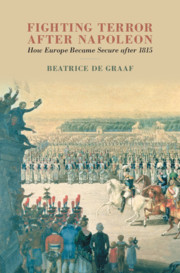Book contents
- Fighting Terror after Napoleon
- Fighting Terror after Napoleon
- Copyright page
- Contents
- Figures
- Maps
- Tables
- Acknowledgements
- Prologue
- 1 Introduction
- 2 Providence in Paris
- 3 Balancing in a Climate of Distress
- 4 ‘A Moderate Occupation’
- 5 Fausses nouvelles and ‘Blacklists’
- 6 Fighting terroristes Together
- 7 The Price of Security
- 8 Fortress Europe
- 9 Beyond Europe
- 10 Conclusion
- Bibliography
- Index
6 - Fighting terroristes Together
Towards a ‘European Police Directorate’?
Published online by Cambridge University Press: 12 September 2020
- Fighting Terror after Napoleon
- Fighting Terror after Napoleon
- Copyright page
- Contents
- Figures
- Maps
- Tables
- Acknowledgements
- Prologue
- 1 Introduction
- 2 Providence in Paris
- 3 Balancing in a Climate of Distress
- 4 ‘A Moderate Occupation’
- 5 Fausses nouvelles and ‘Blacklists’
- 6 Fighting terroristes Together
- 7 The Price of Security
- 8 Fortress Europe
- 9 Beyond Europe
- 10 Conclusion
- Bibliography
- Index
Summary
In 1818, the Allied Council had stabilized the Bourbon regime, and implemented principles of demilitarization and de-Bonapartization. However, the implementation of ‘indirect rule’ was met with increasing resistance among the French populace, and the Allies began to doubt whether the occupation of France was contributing to the security of the country, and by extension, of Europe: a worry that reached its culmination when the Duke of Wellington was attacked. Allied policies meant to discourage Bonapartist sympathies and secure Europe seemed to fuel polarization and radicalization in France instead. By exiling and imposing strict disciplinary measures against suspected Bonapartists and radicals, they had inadvertently spread revolutionary sentiment beyond France’s borders, especially to vulnerable neighbour states such as Belgium. The costs of the occupation and the humiliation of the French through reparation measures put a further heavy burden on the political and social peace of post-Napoleonic Europe.
- Type
- Chapter
- Information
- Fighting Terror after NapoleonHow Europe Became Secure after 1815, pp. 258 - 301Publisher: Cambridge University PressPrint publication year: 2020

